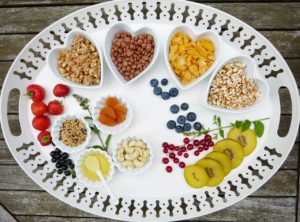 A common approach when losing weight is to simply reduce the calories. After all, if the amount you take in is less than the amount you burn you’ve got to start using those fat reserves right?
A common approach when losing weight is to simply reduce the calories. After all, if the amount you take in is less than the amount you burn you’ve got to start using those fat reserves right?
Wrong. Not all calories are “equal” in nutrition terms. 100 calories from table sugar isn’t the same as 100 calories from fruit (it’s about what a piece of fruit like an apple or banana contains).
Our bodies need three macro-nutrients (macros for short) to function: fat, carbohydrate and protein. Ensure you get the balance of those nutrients right and you will lose weight, gain muscles and have a diet plan you can stick to for life. You can have your cake and eat it – literally!
Let’s have a closer look at each type of macro.
Fat
Fat gets a bad press but it’s actually present in every single cell in your body. There are certain nutrients your body needs that it can only obtain from fat. Healthy fats, such as those in nuts, avocado and seeds are an essential part of a healthy diet.
Carbohydrate
Your body will utilise carbohydrate as a fuel when it needs to burn energy quickly – on days when you’re exercising for example. You should be aiming to get most of your carbs from slow-burn sources such as wholewheat pasta, brown rice and other starchy foods rather than from sugars.
Protein
Often called the building blocks of the body. Protein is what your body needs to make muscles and keep them in tip-top condition. It’s found in meat, fish, eggs as complete protein (containing everything your body needs) and beans, grains, nuts and seeds as incomplete protein (meaning you need to eat different sources to get everything your body needs – for example lentil dhal with rice).
Keep it balanced
To start counting macros you essentially share your calorie intake across the three macro groups. A “starter” balance could be 40% protein, 40% carbs and 20% fat. On exercise days you might increase the carb percentage giving you something more like 50% carbs, 30% protein and 20% fat or for weight loss, you might want to increase the protein percentage giving a balance more like 45% protein, 30% carbs and 25% fat. You can then translate that into what weight of each macro you need to eat.
What you actually eat is up to you so if you fancy a pizza and a glass of wine that’s fine as long as the balance adds up across the rest of the day. You still need to keep the bulk of your diet (at least 80%) as nutritious foods but literally, nothing is off the menu which many fans of macro counting say makes it easier to adhere to.
Weighing everything might seem like a chore but there are plenty of tracking apps out there to make it easier that let you enter your details and what you’ve eaten so you know whether or not you’re on target.
 Healthy Eating Nutrition Tips for Busy Lifestyles
Healthy Eating Nutrition Tips for Busy Lifestyles  Tech for a Tranquil Mind – Apps and Devices for Mental Wellness
Tech for a Tranquil Mind – Apps and Devices for Mental Wellness  Is it time to embrace Quiet Living?
Is it time to embrace Quiet Living?  Escaping the procrastination trap-how to start your focus era
Escaping the procrastination trap-how to start your focus era  Managing Type-2 Diabetes
Managing Type-2 Diabetes  The 15-Minute Movement Habit -Simple Desk Exercises for Working Bloggers
The 15-Minute Movement Habit -Simple Desk Exercises for Working Bloggers  Learning More About Magic: The Gathering – Kindred Decks
Learning More About Magic: The Gathering – Kindred Decks  The Most Popular Planes in Magic: The Gathering
The Most Popular Planes in Magic: The Gathering